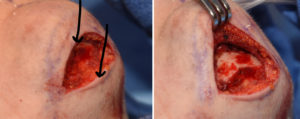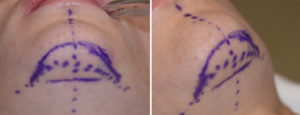Unlike chin augmentation, chin reduction surgery is performed far less commonly. As a result, it is not a well understood procedure in terms of proper diagnosis and technique. While chin reduction is often perceived as an intraoral bony burring procedure, this is a very limited procedure that is rarely effective and often leads to postoperative ptosis problems. There are very indications for it.
Many chin excess problems are a combination of both bone and soft tissue. It is hard to separate the two as bone reduction alone causes a potential lack of overlying soft tissue support creating a tissue sag. While an intraoral osteotomy approach does maintain the attachments of the lower soft tissue chin pad (and this helps in preventing ptosis), the chin osteotomy technique limits what bony dimensional changes are possible and can still not get rid of a large soft tissue pad.



One important feature of coming from below in chin reduction is the possibility of resuspending the neck tissues that are often need to be detached when performing a vertical bone reduction. By doing so this prevents a secondary submental fullness which is what occurs when a sliding genioplasty is done in reverse.
Dr. Barry Eppley
Indianapolis, Indiana


